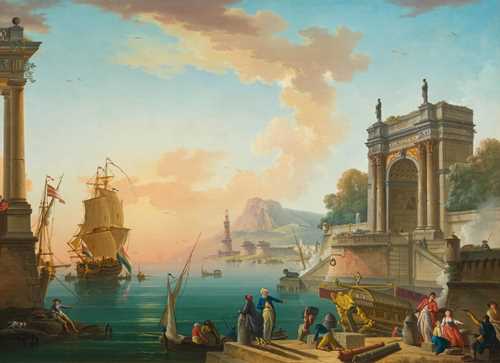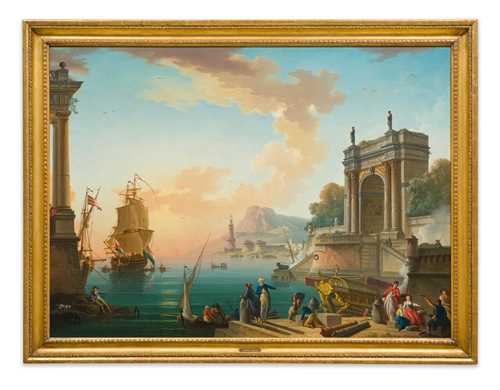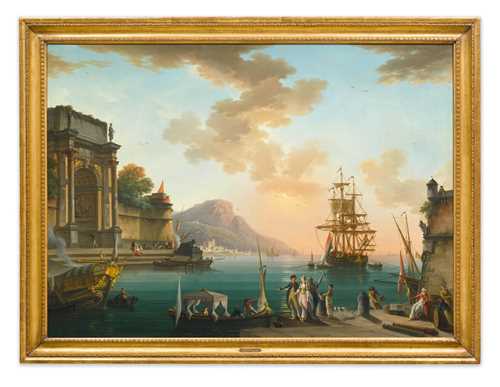
Lot 3073 - A192 Old Master Paintings - Friday, 19. June 2020, 02.00 PM
CHARLES FRANCOIS LACROIX DE MARSEILLE
(Marseille c. 1700–1782 Berlin)
Pair of works: Mediterranean harbour views. 1776.
Oil on canvas.
One signed and dated lower right on the barrel, one signed and dated lower left: De Lacroix. 1776.
106.7 × 146.5 cm / 108.3 × 149.3 cm.
Provenance:
- Partridge Fine Arts, London, 1999.
- Swiss private collection, acquired from the above.
These atmospheric and richly detailed Mediterranean harbour views have been in an important Swiss private collection for over two decades and are excellent examples of Lacroix de Marseille’s masterful mature works. While Lacroix is known for his numerous marine and imaginary landscapes, often produced in pairs and in smaller formats, ambitious compositions of the size of the present pair of works are much more rare.
Lacroix's years of training are not documented. His name suggests that he was probably born in the port city of Marseille and, due to clear stylistic parallels to the oeuvre of Claude-Joseph Vernet (1714–1789), it is assumed that Lacroix was his student. The two earliest known works by Lacroix are Italian sea views signed and dated 1743, exhibited at Galerie Heim in Paris in 1956 and executed in a style that closely approaches that of Vernet.
In 1750 Lacroix was in Rome, where he met the Marquis de Vandières (1727–1781). Located today in the Toledo Museum of Art in Ohio, his harbour view signed “Grenier. De La.Crois. Fecit Rom 1750” is considered one of his greatest masterpieces (see exh. cat. France in the Eighteenth Century, Royal Academy, London 1968, p. 86, no.358). In 1751 in Uppark, Sussex, Lacroix produced copies of four Vernet works that were likewise created in Uppark that year. It is therefore believed that both artists were working side by side at the time. In a 1985 exhibition catalogue, art historian St. John Gore pointed out that Lacroix's paintings and Vernet's works are so exact in every detail of brushwork that were it not for the signatures it would be impossible to distinguish them from one another (see G. Jackson-Stops, The Treasure Houses of Great Britain, New Haven and London 1985, p. 280).
When Vernet returned to France in 1753, Lacroix stayed at least another decade in Italy, where he was known as "Della Croce" and enjoyed great success as a painter of imaginary seascapes such as the works offered here. Lacroix was in Naples in 1757 and may have spent more than a decade there before returning to France, where his presence can be documented from 1776 onward.
He was thus in France when he painted the present works dated 1776 and he participated in the Salon du Colisée in Paris that same year. Lacroix de Marseille enjoyed great popularity among both Italian and French collectors during his lifetime. According to the records of French publicist and contemporary of the artist, Pahin de la Blancherie (1752–1811), Lacroix died in Berlin in 1782.
- Partridge Fine Arts, London, 1999.
- Swiss private collection, acquired from the above.
These atmospheric and richly detailed Mediterranean harbour views have been in an important Swiss private collection for over two decades and are excellent examples of Lacroix de Marseille’s masterful mature works. While Lacroix is known for his numerous marine and imaginary landscapes, often produced in pairs and in smaller formats, ambitious compositions of the size of the present pair of works are much more rare.
Lacroix's years of training are not documented. His name suggests that he was probably born in the port city of Marseille and, due to clear stylistic parallels to the oeuvre of Claude-Joseph Vernet (1714–1789), it is assumed that Lacroix was his student. The two earliest known works by Lacroix are Italian sea views signed and dated 1743, exhibited at Galerie Heim in Paris in 1956 and executed in a style that closely approaches that of Vernet.
In 1750 Lacroix was in Rome, where he met the Marquis de Vandières (1727–1781). Located today in the Toledo Museum of Art in Ohio, his harbour view signed “Grenier. De La.Crois. Fecit Rom 1750” is considered one of his greatest masterpieces (see exh. cat. France in the Eighteenth Century, Royal Academy, London 1968, p. 86, no.358). In 1751 in Uppark, Sussex, Lacroix produced copies of four Vernet works that were likewise created in Uppark that year. It is therefore believed that both artists were working side by side at the time. In a 1985 exhibition catalogue, art historian St. John Gore pointed out that Lacroix's paintings and Vernet's works are so exact in every detail of brushwork that were it not for the signatures it would be impossible to distinguish them from one another (see G. Jackson-Stops, The Treasure Houses of Great Britain, New Haven and London 1985, p. 280).
When Vernet returned to France in 1753, Lacroix stayed at least another decade in Italy, where he was known as "Della Croce" and enjoyed great success as a painter of imaginary seascapes such as the works offered here. Lacroix was in Naples in 1757 and may have spent more than a decade there before returning to France, where his presence can be documented from 1776 onward.
He was thus in France when he painted the present works dated 1776 and he participated in the Salon du Colisée in Paris that same year. Lacroix de Marseille enjoyed great popularity among both Italian and French collectors during his lifetime. According to the records of French publicist and contemporary of the artist, Pahin de la Blancherie (1752–1811), Lacroix died in Berlin in 1782.
CHF 200 000 / 300 000 | (€ 206 190 / 309 280)
Sold for CHF 219 900 (including buyer’s premium)
All information is subject to change.





